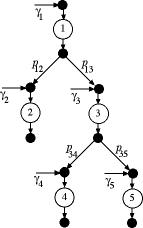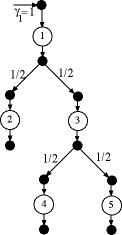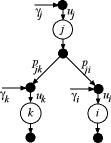| |
In this section we consider
the push/tree process. Many of the definitions and computations
associated with the various drive/structure alternatives are
the same as for the pull/tree. We limit our discussion to those
aspects that are different. The principal changes are in the
data defining the tree structure, the definition of the proportion
parameter and the computation of the unit flow. |
| |
Push/Tree
Process

Figure 1
|
The generic push/tree process is illustrated
in Figure 1. For this structure the flow through each
operation comes from a unique preceding operation, while
each operation may have several output flows to other
operations. Product is inserted or pushed into the operation
with the smallest index, operation 1 for the example,
in the amount  .
We usually assume that this amount is 1. In addition to the initial operation of the process, our
models also allow flow to be pushed into the other operations.
These products entering the system at intermediate points.
In general, we identify the amount pushed into the input
of operation i as  ,
the push flow at operation i. ,
the push flow at operation i.
For tree structures we require that the operations be
indexed so that when flow passes from operation i to
operation j, i < j.
For the push tree we identify the proportion,  ,
as the proportion of the output of operation i that
is sent to operation j. The value of ,
as the proportion of the output of operation i that
is sent to operation j. The value of  may
be any positive amount to represent a variety of manufacturing
situations. may
be any positive amount to represent a variety of manufacturing
situations. |
|
Tabular
Representation |
| |

Figure 2
|
We use Fig. 2 as a numerical example.
Here we push 1 into operation 1 and nothing into the
other operations.
For this illustration, we are assuming that 10% of the
units passing through each operation are scrapped. We also
assume proportions of 0.5 for operations 2 through 5. This
means that operation 1 sends half of its output to each
of operations 2 and 3. Further, operation 3 sends half
of its output to each of operations 4 and 5. Units are
removed from the operations with no successor operations
in the amounts required to fulfill the pushed input flows. |
|
| 
|
We represent the data
for the example push tree with a two-dimensional table as illustrated
below. Here we provide only the columns necessary to show the
tree structure and compute flows. Later we add other operational
data.
| Name |
Index |
Previous |
Push
In |
Scrap |
Group |
Proportion
|
| Op.
1 |
1 |
0 |
1 |
0.1 |
1 |
1 |
| Op.
2 |
2 |
1 |
0 |
0.1 |
1 |
0.5 |
| Op.
3 |
3 |
1 |
0 |
0.1 |
1 |
0.5 |
| Op.
4 |
4 |
3 |
0 |
0.1 |
1 |
0.5 |
| Op.
5 |
5 |
3 |
0 |
0.1 |
1 |
0.5 |
For the push tree, an operation can obtain its input from no
more than one other operation, so the column labeled Previous
is sufficient to describe the tree structure. The column labeled
Proportion gives the proportion of the output of the
previous operation that is sent to the operation. The number
(0.5) in the row for Op. 2, holds the value of  . .
For the push/tree structure we define the following notation.
We use i for the general operation index.
-
 = the index of the operation preceding (or before) operation
i. This is the number in the Previous column.
= the index of the operation preceding (or before) operation
i. This is the number in the Previous column.
 = the flow pushed into the input of operation i.
= the flow pushed into the input of operation i.  = the proportion of flow that is scrapped or removed at operation
i.
= the proportion of flow that is scrapped or removed at operation
i. = the number of items grouped at operation i.
= the number of items grouped at operation i. = the proportion of the output of operation
= the proportion of the output of operation  that is sent to operation i.
that is sent to operation i. = the time required for one unit to pass through operation
i. (not shown in the table)
= the time required for one unit to pass through operation
i. (not shown in the table)
We use the symbol b as the first subscript on  to indicate that it is the proportion of the output of the preceding
operation that is sent to operation i. When an operation
has no preceding operation we assign the value 0 to
to indicate that it is the proportion of the output of the preceding
operation that is sent to operation i. When an operation
has no preceding operation we assign the value 0 to  ,
and ,
and  has no effect.
has no effect.
The Excel model created by the Process Flow add-in
is shown below. The add-in adds dummy operations 0 and 6. Indices
are automatically assigned by the add-in, as indicated by the
green field. The Previous column represents the tree
structure of Fig. 1. The Push In column shows 1 unit
pushed into operation 1. We have indicated arbitrary times in
the Operation Time column. The Scrap Rate,
Group Factor and Proportion columns are filled
with the data specified for the example. |
|
| 
|
The columns
starting with J are computed using formulas inserted by the
add-in. Our purpose in this section is to provide the derivation
of these formulas for the push/tree process. |
Scrap and Flow Removed |
| 
|
This is the same as the
pull/tree structure. |
Grouping, Flow Removed
and Ratio |
| 
|
The computations are
the same as for the pull/tree structure.
The example shows the flow ratios in the columns
labeled Ratio (K). Since all scrap rates are 0.1 and
all grouping factors are 1, all ratios are 0.9. |
Unit Flow |
| |

Figure 3 |
For operation i in
Fig. 3, the value of  is
entirely dependent on the push flow added at operation i and
the amount passed from operation j. Since the
amount from operation j is is
entirely dependent on the push flow added at operation i and
the amount passed from operation j. Since the
amount from operation j is  we
have the relation between the unit flows at i and j. we
have the relation between the unit flows at i and j.

Notice that the unit flow for an operation
depends on the unit flow of its unique preceding operation.
For the push/tree process, the unit flows can be computed
recursively, starting with the  and
continuing for each operation with sequentially increasing
operation index. The results for the example are shown
in the Unit Flow column (L) of the Excel display.
Notice the unit flow through operation 5 is 0.2025. This
means that for 1 unit of product introduced at operation
1, 0.2025 units must pass through operation 5. If the scrap
rates were zero, all ratios would have been 1, and the
unit at flow operation 5 would have been entirely determined
by the proportions. The unit flow at operation 5 would
have been 0.25 in this case. and
continuing for each operation with sequentially increasing
operation index. The results for the example are shown
in the Unit Flow column (L) of the Excel display.
Notice the unit flow through operation 5 is 0.2025. This
means that for 1 unit of product introduced at operation
1, 0.2025 units must pass through operation 5. If the scrap
rates were zero, all ratios would have been 1, and the
unit at flow operation 5 would have been entirely determined
by the proportions. The unit flow at operation 5 would
have been 0.25 in this case. |
|
Unit Time |
| 
|
The computations are the same as for the pull/tree
structure. The results are shown in column M. The sum of the
operation unit time values is the total time in the system
for each unit entering node 1. For a serial system, this is
the cycle time for the product. In the more general context
we call it the throughput time. This sum is computed and stored
in cell K16.
|
Operation Flow |
| 
|
The computations are the same as for the pull/tree
structure. The results are shown in column N.
|
Work-in-Process (WIP) |
| 
|
The computations are
the same as for the pull/tree structure. The results are shown
in column O.
The sum of the operation WIP values is the average
WIP of the entire process. This sum is computed and stored in
cell K17. |
| |
|



